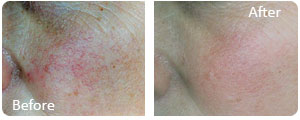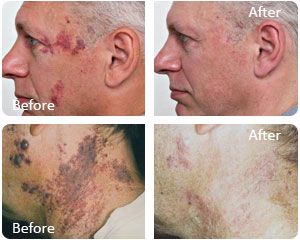Vascular Lesions / Thread Veins
A large proportion of the population suffer from disorders of blood vessels. These range in size from small telangiectasias (small thread veins, spider naevi) to larger Port Wine Stains or birth marks. Most people choose to cover these up with make-up. These skin lesions can cause significant psychological trauma. The Ellipse IPL treatment offers an effective and clinically proven therapy to remove these lesions. 
Frequently asked Questions
How does the Ellipse I2PL system treat Vascular Lesions/Thread Veins? A thread vein is a small blood vessel near the surface of the skin. The Ellipse operator guides the visible light from the flash-lamp to the blood vessels needing treatment. The unique Ellipse I2PL system carefully filters this light in two ways to ensure that only light with the correct characteristics (wavelengths) is allowed to reach your skin. Blood contains haemoglobin that absorbs the light and converts it into heat. This heat destroys the protein in the wall of the thread vein. As a result the veins will gradually, and safely, disappear after treatment. To ensure optimal light transmission to the blood vessel, a thin layer of gel (similar to that used in ultrasound examinations) is applied to your skin before treatment.
Which thread veins can be treated?
Thread veins on all parts of your body can be treated. The most common treatments are for superficial veins in the facial, chest or leg areas. As the treatment relies on absorption of light by the haemoglobin in the blood, the most effective results are seen with light skin. The lighter the skin, the more pronounced the contrast between the vessel and the skin, making treatment easier. However, Ellipse has pre-programmed settings for different skin colours that deliver the correct energy output for your complexion.
How long does an Ellipse treatment take?
The glass prism within the Ellipse applicator that guides the light to the skin is 10mm by 48mm, so several vessels can be targeted in one flash of light. The treatment time depends on the area to be covered and the number of distinct vessels to be treated. A single session typically lasts 10-20 minutes.
Does it hurt?
Tolerance of pain is very individual from person to person. No anaesthetics are required, and most people describe the sensation as similar to that of a rubber band snapping onto the skin, followed by a warm sensation lasting several minutes. You may find it comforting to cool the skin after the treatment.
Do I need to take special precautions before and after treatment?
The light used is completely safe, visible light. Potentially harmful wavelengths are removed by the unique Ellipse Dual Mode Filtering system. Since tanning takes place by accumulation of pigment (melanin) in the skin, it is, however, important to avoid tanning (sun, solarium or self-tanning cream) before and during the treatment period. Otherwise your tanned skin will absorb more light, which makes treatment less effective. Generally, no post-treatment care is needed. But people with sensitive skin may benefit from using a soothing cream for a few days after treatment. We recommend you limit sun exposure and use a sunscreen (SPF 60) for a few weeks following treatment. After treatment of thread veins on the legs, compression (surgical) stockings should be worn for two weeks. If larger veins on the leg have already been treated (surgery or sclerotherapy), Ellipse treatment should be delayed for at least one month to allow the healing process to be complete first.
How many Ellipse treatments do I need?
The number of treatments depends on the body site and the severity of the thread vein. Clinical studies have confirmed that 1-4 treatments usually are needed, and these are timed about one month apart.
How can I be sure Ellipse is safe and effective?
Clinical trials documenting Ellipse’s safety and effectiveness are carried out by leading doctors prior to the release of the product. The results of these tests are then published in respected, refereed medical journals. You are welcome to view these scientific papers on the Ellipse website at www.ellipse.org. The settings used for your treatment will be based on the settings recommended by the clinicians who carried out the clinical trials.
